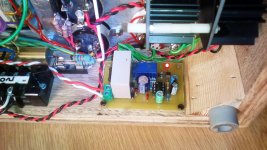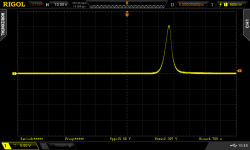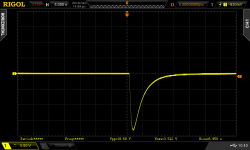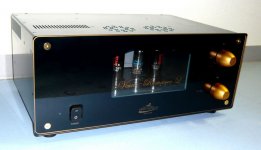Zactly. It's a simple AC shunt using a 6L6GC. I've been wanting to learn more about shunt supplies (particularly tubes) and had some room in the chassis and a big power transformer.
Practically speaking, I was running into limiting factors with a DC regulated tube shunt; series regulators, in comparison, are more straightforward with tubes. Though I'm not sure SS has it that much easier as a shunt. Dissipation is dissipation either way.
This does sound very good. The microphonics of the big tubes surprised me but they aren't awful.
Practically speaking, I was running into limiting factors with a DC regulated tube shunt; series regulators, in comparison, are more straightforward with tubes. Though I'm not sure SS has it that much easier as a shunt. Dissipation is dissipation either way.
This does sound very good. The microphonics of the big tubes surprised me but they aren't awful.
Yes its a musically engaging sound. Some give in the bases mounting with elastic rings and sorbothane feet under the chassis could help on microphonics. Then again if you don't absolutely need line gain the CF buffer alternative version cuts on vibration sensitivity too.
Thanks for the tips. I'll play with some different feet to minimize microphonics. Really not a problem even with fairly loud music but I suppose different tubes will react in different ways and it could always end up in a more vibration-prone music rack.
Followers are usually what I like for "preamps" but it's nice to have found a good low gain approach, too. 12B4s and 6AH4s are appealing alternatives but not current production anymore.
Thanks for all the inspiration you provide on the forum, Salas!
Followers are usually what I like for "preamps" but it's nice to have found a good low gain approach, too. 12B4s and 6AH4s are appealing alternatives but not current production anymore.
Thanks for all the inspiration you provide on the forum, Salas!
1) The transformer choice depends on the rectifier type's loss. <snip>
Thanks Salas. I was planing to use GZ34. PSU simulator is installed 🙂. When parts comes I will start with questions 😱.
1Q: 6V6 and EL84 are similar so is there EL84 preamp?
In the buffer version yes, the EL84 (6BQ5) can work comparably. In the gain version not so much, it would bring excessive gain more Zout and more THD, I would have preferred a step down output transformer for that tube if in a line gain circuit.
In the buffer version yes, the EL84 (6BQ5) can work comparably. In the gain version not so much, it would bring excessive gain more Zout and more THD, I would have preferred a step down output transformer for that tube if in a line gain circuit.
Build a buffer version, buy adapters and tubes (el84) and enjoy.😀
Are there still some really NOS condition Ei Yugoslavia EL84 in circulation locally? That product was very good.
Perhaps 6AQ5/6P1P-EV more suitable?
Surely in the gain version. Could be good on microphonics too since its a smaller bottle.
Sometimes. Maybe EL84 EI Yugoslavia 6BQ5 | TUBES.RS – Tube Amplifiers & NOS TubesAre there still some really NOS condition Ei Yugoslavia EL84 in circulation locally? That product was very good.
Last edited:
Nick as an end result, it can block up to one point the bumps ,for as long time as we give him on this circuit, but it also protects the regulators from falling unloaded.
The next circuit i will make that will check for the absence of voltage filament, but also the level of the DC voltage output.
The next circuit i will make that will check for the absence of voltage filament, but also the level of the DC voltage output.
So you are going to make it full proof for cathode stripping and regs loading as well as safe for any power up or power down sequence of the whole audio system. The traditional way to just avoid delayed bumps is we wait for the preamp's tubes to fully glow before turning on the power amplifier and in the end we shut him down first.
Yes Nick
But this first dealy circuit it does not protect , if anything is done and the preamplifier is disconnected and the amplifier is still open.
But this first dealy circuit it does not protect , if anything is done and the preamplifier is disconnected and the amplifier is still open.
You want to make it fail benign by monitoring internal circuits and its output. Nice & sophisticated approach. Not a luxury idea exactly because you mix it with the powerful solid state DC coupled amps you got. I suggest you monitor the rectifier tube's heater too. That tube is central and less lasting than the signal tubes.
In what way? Like less SQ due to a relay in the preamp's output signal path? No I don't think so.
- Home
- Amplifiers
- Tubes / Valves
- 6V6 line preamp



